Evaluation of Coconut Fiber in Corroded Reinforced Self-Healing Concrete Using NDT Methods
Abstract
:1. Introduction
2. Research Significance
3. Materials and Methods
3.1. Materials
3.2. Methods
3.2.1. Mix Design
3.2.2. Preparation of Specimens
3.2.3. Acceleration of Corrosion
3.2.4. Compressive Strength and Flexural Strength
3.2.5. Electrical Resistivity
3.2.6. Impact Echo
4. Results and Discussion
4.1. Compressive Strength
4.2. Accelerated Corrosion
4.3. Electrical Resistivity
4.4. Impact Echo
4.5. Flexural Strength
4.6. Relationship between RE and IE Values
5. Conclusions
- CFR-SHC has lower compressive strength values compared to normal concrete. The addition of 0.25% CF obtained 2% lower strength than normal concrete, but it needs to be noted because of the large standard deviation. Then, the addition of 0.5% and 0.75% increased the compressive strength up to 6% compared to normal concrete by 0.5% CF.
- In the accelerated corrosion test, CFR-SHC has very good resistance to chloride ions compared to normal concrete, as shown by the always-lower current. From 48 h to 96 h, 0.75% CF had the lowest current, and it increased unsteadily until 168 h. However, in the final calculation, the actual corrosion rate of CF 0.5% was the smallest, 54% lower than normal concrete.
- The flexural strength of the corroded CFR-SHC is inversely proportional to the corrosion rate. All CFR-SHCs obtained higher flexural strengths than normal concrete at higher corrosion rates. The 0.5% CF has a 40% higher flexural strength than normal corroded concrete.
- ER testing provides an evaluation of CFR-SHC due to the corrosion process, where ER is inversely proportional to the corrosion rate. Based on the ER results before corrosion, all specimens are still in the “very low” category for the corrosion rate. After corrosion, CF 0.75% obtains the largest ER value compared to other CFR-SHC mixes.
- The IE test results deliver the peak frequency value, which is inversely proportional to the corrosion rate. Before being corroded, CFR-SHC had a higher frequency than normal concrete. At the beginning of corrosion, normal concrete was superior in frequency value, but at 0.25% CF weight corrosion, the frequency was 37% higher than normal concrete. Thus, the IE and ER methods in the tests conducted can effectively evaluate potentially corroded concrete and concrete that has been affected by corrosion.
Author Contributions
Funding
Institutional Review Board Statement
Informed Consent Statement
Data Availability Statement
Conflicts of Interest
References
- Alomayri, T.; Yosri, A.M.; Ali, B.; Raza, S.S.; Yaqub, M.; Kurda, R.; Deifalla, A.F. The influence of coconut fibres and ground steel slag on strength and durability properties of recycled aggregate concrete: Sustainable design of fibre reinforced concrete. J. Mater. Res. Technol. 2023, 24, 10027–10039. [Google Scholar] [CrossRef]
- Kurda, R.; De Brito, J.; Silvestre, J.D. Combined Economic and Mechanical Performance Optimization of Recycled Aggregate Concrete with High Volume of Fly Ash. Appl. Sci. 2018, 8, 1189. [Google Scholar] [CrossRef]
- Kurda, R.; Silvestre, J.D.; de Brito, J. Life cycle assessment of concrete made with high volume of recycled concrete aggregates and fly ash. Resour. Conserv. Recycl. 2018, 139, 407–417. [Google Scholar] [CrossRef]
- Oh, D.-Y.; Noguchi, T.; Kitagaki, R.; Park, W.-J. CO2 emission reduction by reuse of building material waste in the Japanese cement industry. Renew. Sustain. Energy Rev. 2014, 38, 796–810. [Google Scholar] [CrossRef]
- Elahi, M.M.A.; Hossain, M.M.; Karim, M.R.; Zain, M.F.M.; Shearer, C. A review on alkali-activated binders: Materials composition and fresh properties of concrete. Constr. Build. Mater. 2020, 260, 119788. [Google Scholar] [CrossRef]
- Marcalikova, Z.; Racek, M.; Mateckova, P.; Cajka, R. Comparison of tensile strength fiber reinforced concrete with different types of fibers. Procedia Struct. Integr. 2020, 28, 950–956. [Google Scholar] [CrossRef]
- Sekar, A.; Kandasamy, G. Study on Durability Properties of Coconut Shell Concrete with Coconut Fiber. Buildings 2019, 9, 107. [Google Scholar] [CrossRef]
- Fediuk, R. Reducing Permeability of Fiber Concrete Using Composite Binders. Spéc. Top. Rev. Porous Media Int. J. 2018, 9, 79–89. [Google Scholar] [CrossRef]
- Althoey, F. Compressive strength reduction of cement pastes exposed to sodium chloride solutions: Secondary ettringite formation. Constr. Build. Mater. 2021, 299, 123965. [Google Scholar] [CrossRef]
- Faridul, H.K.M.; Haona, W.; Sakil, M.; Abu, T.M.; Cao, G. Wool functionalization through AgNPs: Coloration, antibacterial and wastewater treatment. Surf. Innov. 2021, 9, 25–36. [Google Scholar] [CrossRef]
- Ede, A.; Aina, A. Effects of Coconut Husk Fibre and Polypropylene Fibre on Fire Resistance of Concrete. Int. J. Eng. Sci. Manag. 2015, 5, 171–179. [Google Scholar]
- Khan, M.; Ali, M. Effect of super plasticizer on the properties of medium strength concrete prepared with coconut fiber. Constr. Build. Mater. 2018, 182, 703–715. [Google Scholar] [CrossRef]
- Ku, H.; Wang, H.; Pattarachaiyakoop, N.; Trada, M. A review on the tensile properties of natural fiber reinforced polymer composites. Compos. Part B Eng. 2011, 42, 856–873. [Google Scholar] [CrossRef]
- Venugopal, B.; Sambamurthy, V. Development and performance evaluation of coir pith ash as supplementary cementitious material in concrete. J. Eng. Technol. Sci. 2018, 50, 856–869. [Google Scholar] [CrossRef]
- Kušter Marić, M.; Ožbolt, J.; Balabanić, G. Reinforced concrete bridge exposed to extreme maritime environmental conditions and mechanical damage: Measurements and numerical simulation. Eng. Struct. 2020, 205, 110078. [Google Scholar] [CrossRef]
- Peng, C.; Wu, Q.; Shen, J.; Mo, R.; Xu, J. Numerical study on the effect of transverse crack self-healing on the corrosion rate of steel bar in concrete. J. Build. Eng. 2021, 41, 102767. [Google Scholar] [CrossRef]
- Zaki, A.; Wibowo, M.A.; Rosyidi, S.A.P.; Mahbubi, K. Corrosion Analysis of Concrete using Resistivity Method. In Proceedings of the 2023 International Workshop on Artificial Intelligence and Image Processing (IWAIIP), Yogyakarta, Indonesia, 1–2 December 2023; pp. 428–432. [Google Scholar] [CrossRef]
- Rahita, A.C.; Zaki, A. Corrosion Analysis on Reinforcing Steel in Concrete Using the Eddy Current Method. In Proceedings of the 2023 3rd International Conference on Electronic and Electrical Engineering and Intelligent System (ICE3IS), Yogyakarta, Indonesia, 9–10 August 2023; pp. 476–480. [Google Scholar] [CrossRef]
- Subeki, N.; Achmad Fauzan Hery, S.; Andi, F.; Gidiazalia, N. Crack Propagation Analysis of Fatigue Due to External Corrosion on the Construction of the Ferris Wheel in Alun-Alun Kota Batu. J. Adv. Res. Appl. Mech. 2023, 111, 62–73. [Google Scholar] [CrossRef]
- Jumaat, Z.; Kabir, M.; Obaydullah, M. A review of the repair of reinforced concrete beams. J. Appl. Sci. Res. 2006, 2, 317–326. [Google Scholar]
- Safiuddin, M.; Ihtheshaam, S.; Kareem, R.A.; Shalam. A study on self-healing concrete. Mater. Today Proc. 2022, 52, 1175–1181. [Google Scholar] [CrossRef]
- Zhang, F.; Ju, P.; Pan, M.; Zhang, D.; Huang, Y.; Li, G.; Li, X. Self-healing mechanisms in smart protective coatings: A review. Corros. Sci. 2018, 144, 74–88. [Google Scholar] [CrossRef]
- Nindhita, K.W.; Zaki, A.; Zeyad, A.M. Effect of Bacillus subtilis Bacteria on the mechanical properties of corroded self-healing concrete. Frat. Ed Integrita Strutt. 2024, 18, 140–158. [Google Scholar] [CrossRef]
- Abu Bakr, M.; Singh, B.K.; Deifalla, A.F.; Pandey, S.; Hussain, A.; Ragab, A.E.; Alvi, S.S.; Hasnain, S.M.M. Assessment of the mechanical and durability characteristics of bio-mineralized Bacillus subtilis self-healing concrete blended with hydrated lime and brick powder. Case Stud. Constr. Mater. 2023, 19, e02672. [Google Scholar] [CrossRef]
- Hammad, N.; Elnemr, A.; Shaaban, I.G. State-of-the-Art Report: The Self-Healing Capability of Alkali-Activated Slag (AAS) Concrete. Materials 2023, 16, 4394. [Google Scholar] [CrossRef] [PubMed]
- Nguyen, H.; Ghorbel, E. Effects of Bacillus subtilis on the compressive strength, porosity and rapid chloride permeability of concrete. Acad. J. Civ. Eng. 2019, 37, 223–228. [Google Scholar] [CrossRef]
- Ahmad, J.; Majdi, A.; Al-Fakih, A.; Deifalla, A.; Althoey, F.; Ouni, M.; El-Shorbagy, M. Mechanical and Durability Performance of Coconut Fiber Reinforced Concrete: A State-of-the-Art Review. Materials 2022, 15, 3601. [Google Scholar] [CrossRef] [PubMed]
- Vasagar, V.; Hassan, M.K.; Abdullah, A.M.; Karre, A.V.; Chen, B.; Kim, K.; Al-Qahtani, N.; Cai, T. Non-destructive techniques for corrosion detection: A review. Corros. Eng. Sci. Technol. 2024, 59, 56–85. [Google Scholar] [CrossRef]
- Ahmad, W.; Farooq, S.H.; Usman, M.; Khan, M.; Ahmad, A.; Aslam, F.; Yousef, R.A.; Abduljabbar, H.A.; Sufian, M. Effect of Coconut Fiber Length and Content on Properties of High Strength Concrete. Materials 2020, 13, 1075. [Google Scholar] [CrossRef]
- Nasser, H.; Van Steen, C.; Vandewalle, L.; Verstrynge, E. An experimental assessment of corrosion damage and bending capacity reduction of singly reinforced concrete beams subjected to accelerated corrosion. Constr. Build. Mater. 2021, 286, 122773. [Google Scholar] [CrossRef]
- Watanabe, T.; Nouchi, A.; Namerikawa, S.; Hashimoto, C. Evaluation of condition on replacing repaired concrete based on NDT and the Mahalanobis–Taguchi system. Front. Built Environ. 2023, 8, 956684. [Google Scholar] [CrossRef]
- Ahmad, J.; Manan, A.; Ali, A.; Khan, M.; Asim, M.; Zaid, O.; Taylor, G. A Study on Mechanical and Durability Aspects of Concrete Modified with Steel Fibers (SFs). Civ. Eng. Archit. 2020, 8, 814–823. [Google Scholar] [CrossRef]
- Sánchez Montero, J.; Saura Gómez, P.; Torres Martín, J.E.; Chinchón-Payá, S.; Rebolledo Ramos, N. Variation of Corrosion Rate, Vcorr, during the Carbonation-Induced Corrosion Propagation Period in Reinforced Concrete Elements. Materials 2024, 17, 101. [Google Scholar] [CrossRef]
- Sharkawi, A.M.; Seyam, A.M. Efficiency of accelerated techniques for assessing corrosion protection of blended cements. Mag. Concr. Res. 2019, 71, 637–646. [Google Scholar] [CrossRef]
- Robles, K.P.V.; Gucunski, N.; Kee, S.-H. Evaluation of steel corrosion-induced concrete damage using electrical resistivity measurements. Constr. Build. Mater. 2024, 411, 134512. [Google Scholar] [CrossRef]
- Su, T.; Wu, J.; Zou, Z.; Wang, Z.; Yuan, J.; Yang, G. Influence of environmental factors on resistivity of concrete with corroded steel bar. Eur. J. Environ. Civ. Eng. 2022, 26, 1229–1242. [Google Scholar] [CrossRef]
- Alhawat, M.; Khan, A.; Ashour, A. Evaluation of Steel Corrosion in Concrete Structures Using Impact-Echo Method. Adv. Mater. Res. 2020, 1158, 147–164. [Google Scholar] [CrossRef]
- Imperatore, S.; Benenato, A.; Spagnuolo, S.; Ferracuti, B.; Kioumarsi, M. Corrosion effects on the flexural performance of prestressed reinforced concrete beams. Constr. Build. Mater. 2024, 411, 134581. [Google Scholar] [CrossRef]





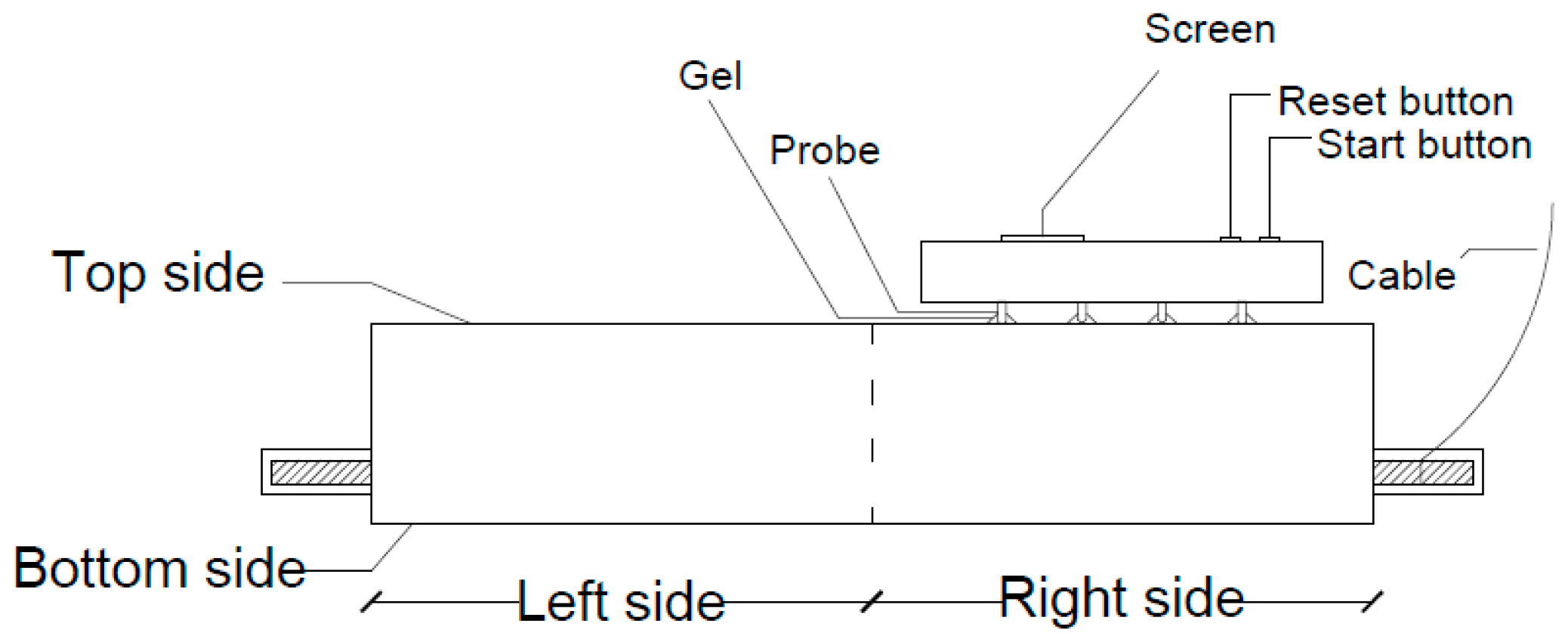

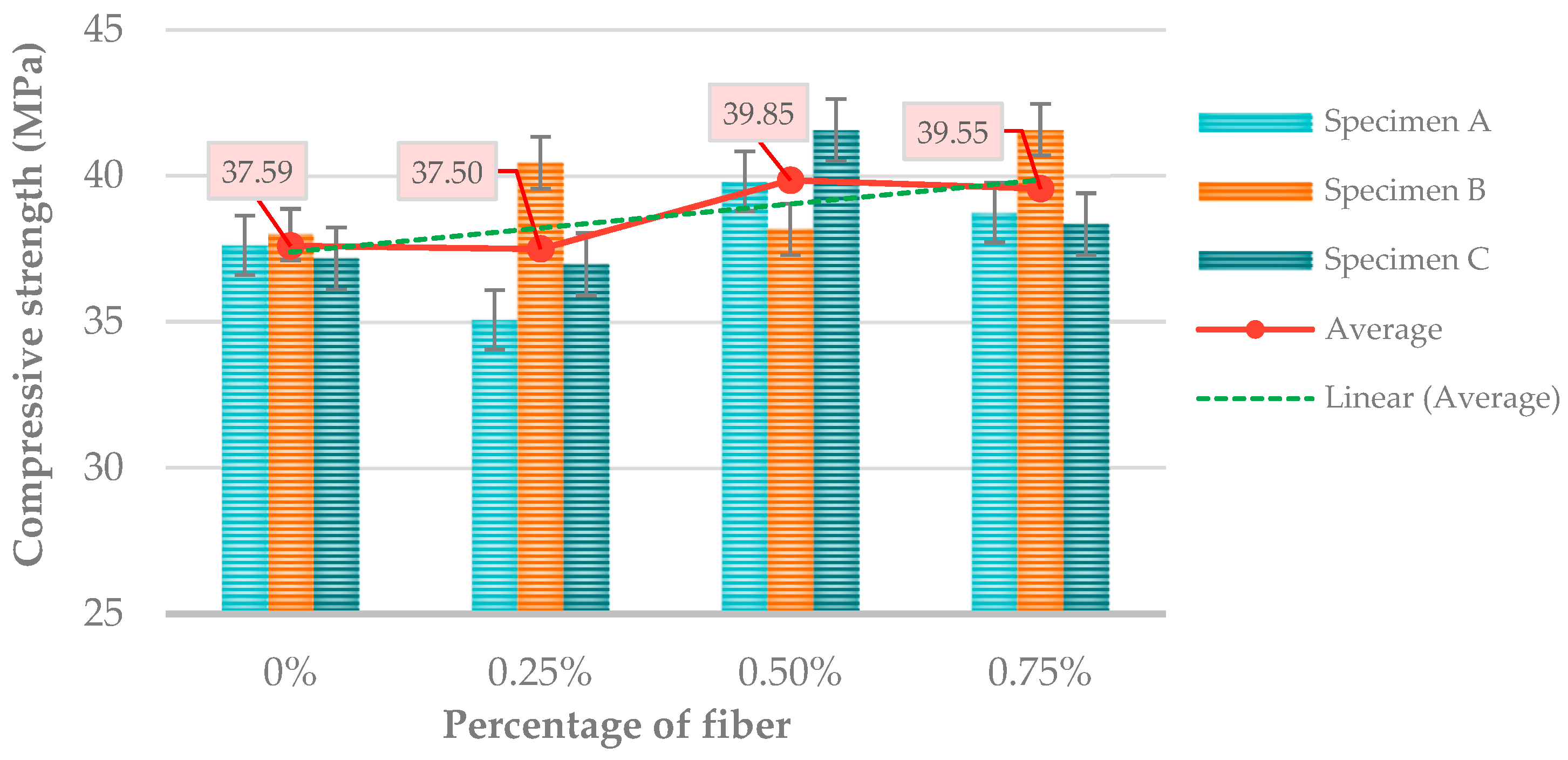
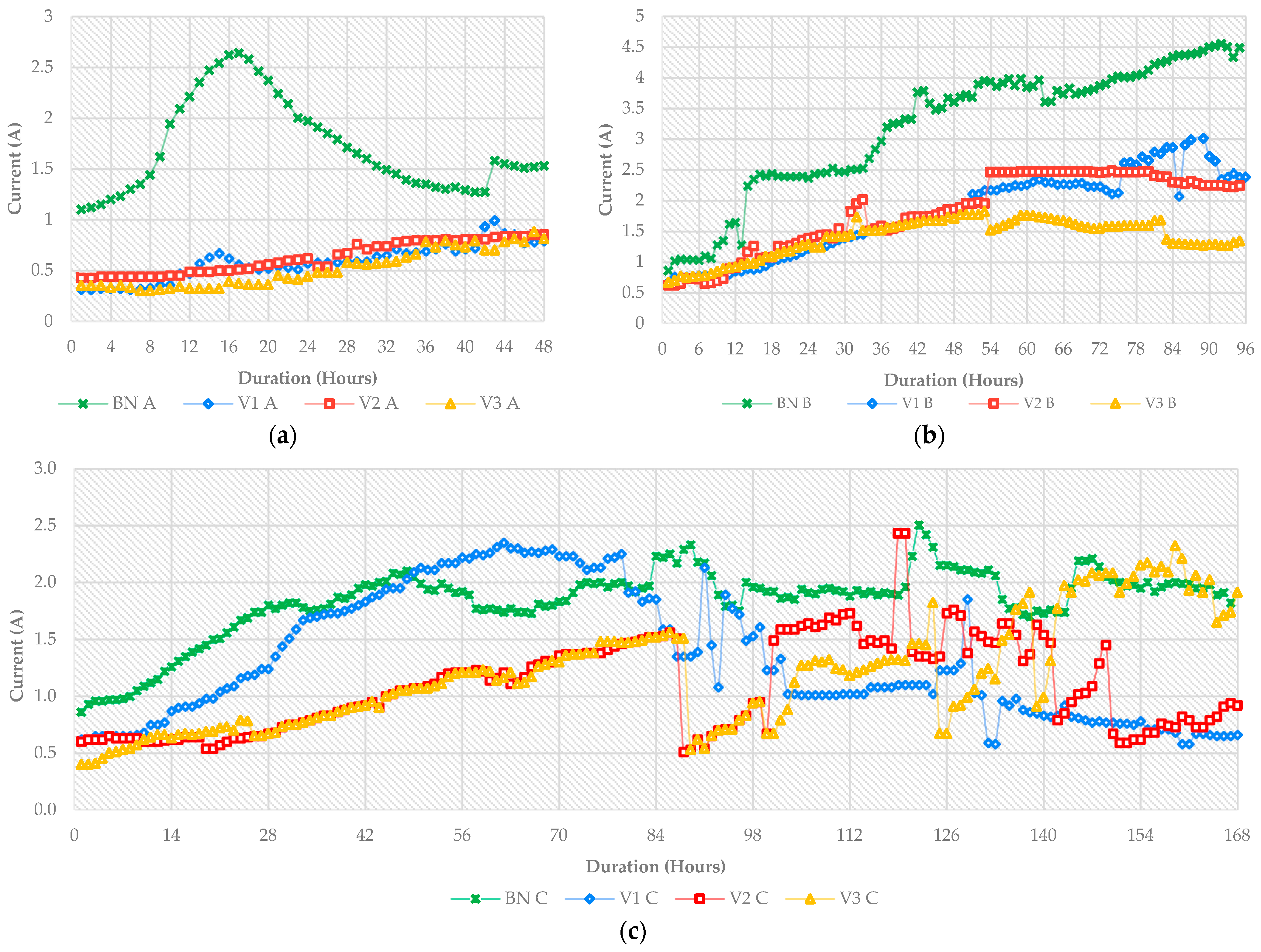
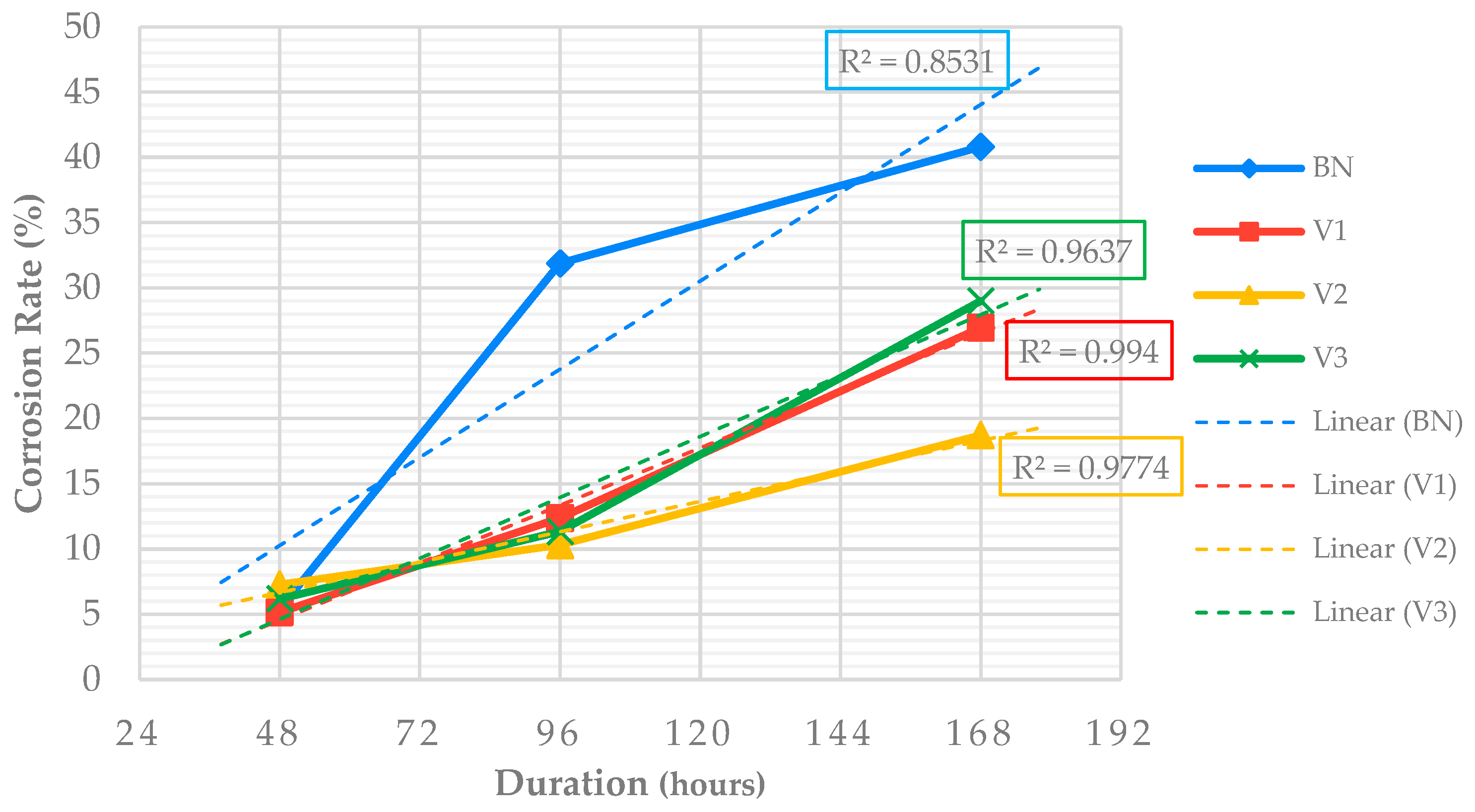
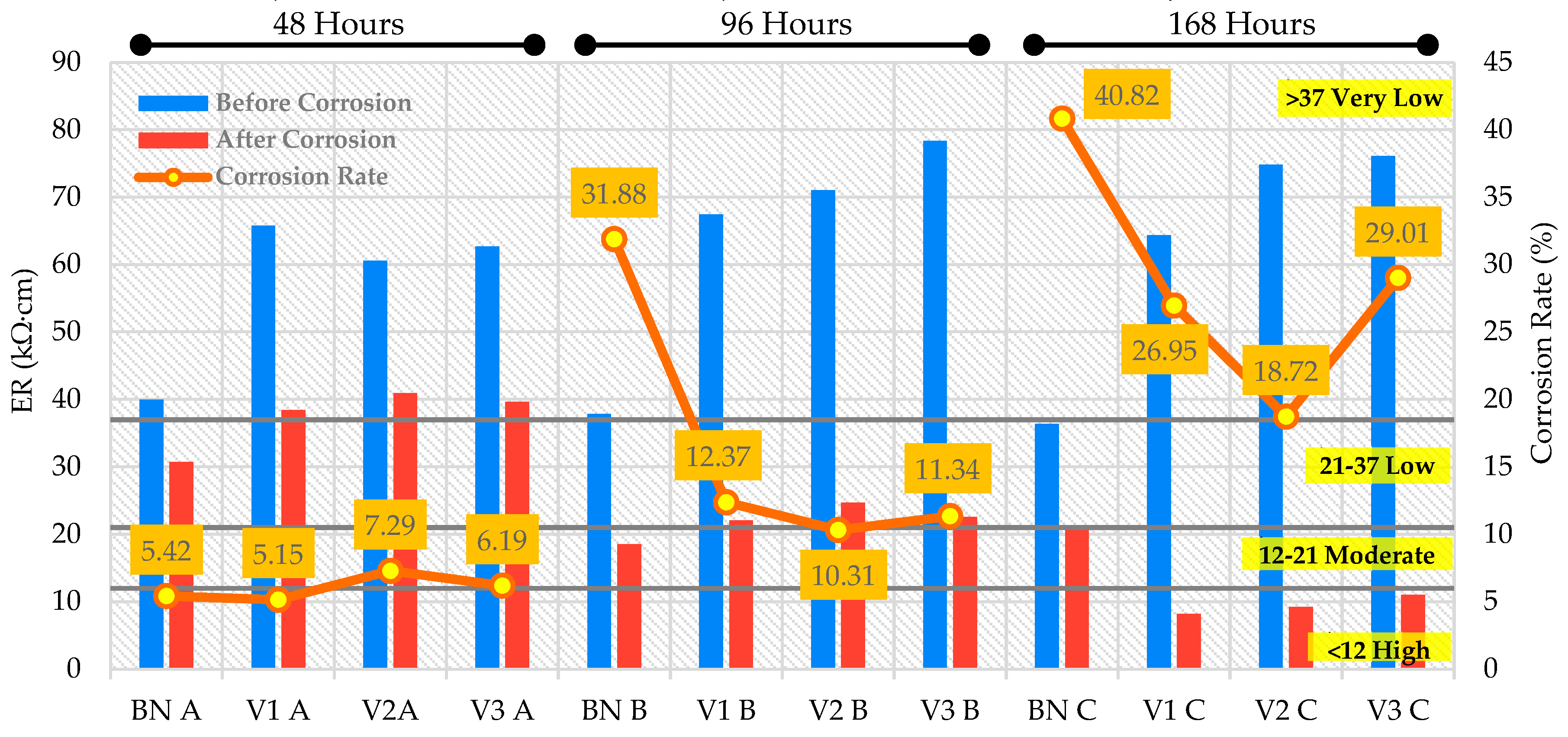

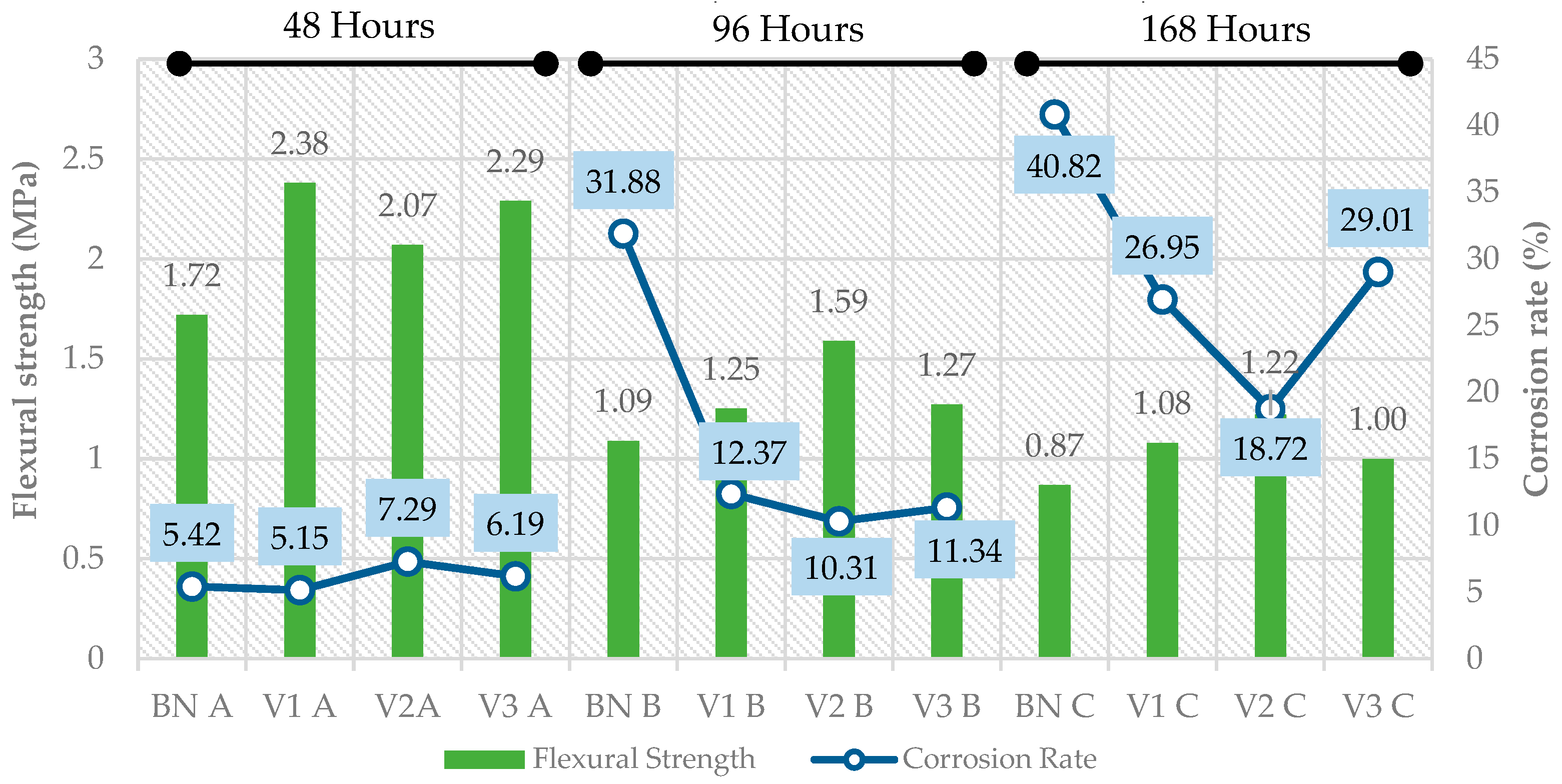

| Test | Fine Aggregate | Coarse Aggregate | Unit |
|---|---|---|---|
| Fine modulus | 2.435 | - | - |
| Bulk specific gravity | 1.837 | 2.642 | - |
| Saturated surface dry specific gravity | 2.242 | 2.707 | - |
| Apparent specific gravity | 3.094 | 2.826 | - |
| Water absorption | 2.165 | 2.459 | % |
| Mud content | 1.00 | 1 | % |
| Abrasion | - | 15.75 | % |
| Code | Water (liters) | Cement (kilograms) | Fine Aggregate (kilograms) | Coarse Agg. (kilograms) | CF (grams) | Bacillus S. (milliliters) |
|---|---|---|---|---|---|---|
| BN | 1.38 | 3.27 | 4.33 | 6.65 | 0 | 0 |
| V1 | 1.38 | 3.27 | 4.33 | 6.65 | 17 | 10 |
| V2 | 1.38 | 3.26 | 4.33 | 6.65 | 33 | 10 |
| V3 | 1.38 | 3.27 | 4.33 | 6.65 | 50 | 10 |
Disclaimer/Publisher’s Note: The statements, opinions and data contained in all publications are solely those of the individual author(s) and contributor(s) and not of MDPI and/or the editor(s). MDPI and/or the editor(s) disclaim responsibility for any injury to people or property resulting from any ideas, methods, instructions or products referred to in the content. |
© 2024 by the authors. Licensee MDPI, Basel, Switzerland. This article is an open access article distributed under the terms and conditions of the Creative Commons Attribution (CC BY) license (https://creativecommons.org/licenses/by/4.0/).
Share and Cite
Zaki, A.; Aprilia, N.C.; Rosyidi, S.A.P.; Mahbubi, K. Evaluation of Coconut Fiber in Corroded Reinforced Self-Healing Concrete Using NDT Methods. NDT 2024, 2, 214-227. https://doi.org/10.3390/ndt2030013
Zaki A, Aprilia NC, Rosyidi SAP, Mahbubi K. Evaluation of Coconut Fiber in Corroded Reinforced Self-Healing Concrete Using NDT Methods. NDT. 2024; 2(3):214-227. https://doi.org/10.3390/ndt2030013
Chicago/Turabian StyleZaki, Ahmad, Nabilah Cantika Aprilia, Sri Atmaja P. Rosyidi, and Khairil Mahbubi. 2024. "Evaluation of Coconut Fiber in Corroded Reinforced Self-Healing Concrete Using NDT Methods" NDT 2, no. 3: 214-227. https://doi.org/10.3390/ndt2030013







